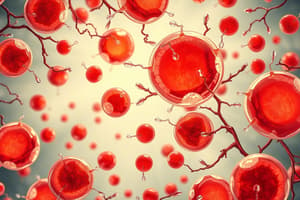Podcast
Questions and Answers
Plasminogen is synthesized in the kidney as an active enzyme.
Plasminogen is synthesized in the kidney as an active enzyme.
False (B)
Plasminogen binds to fibrin throughout the developing thrombus.
Plasminogen binds to fibrin throughout the developing thrombus.
True (A)
Urokinase Plasminogen Activator (UPA) is an extrinsic plasminogen activator.
Urokinase Plasminogen Activator (UPA) is an extrinsic plasminogen activator.
False (B)
Plasmin has narrow substrate specificity, mainly targeting fibrin polymer degradation.
Plasmin has narrow substrate specificity, mainly targeting fibrin polymer degradation.
TAFI activity is not localized to the fibrin clot and remains active when not associated with fibrin surfaces.
TAFI activity is not localized to the fibrin clot and remains active when not associated with fibrin surfaces.
PAI-1 binds to circulating active plasmin, inhibiting its fibrinolytic activity.
PAI-1 binds to circulating active plasmin, inhibiting its fibrinolytic activity.
Thrombin-activatable fibrinolysis inhibitor (TAFI) is a pro-inflammatory protein.
Thrombin-activatable fibrinolysis inhibitor (TAFI) is a pro-inflammatory protein.
The binding of TPA to fibrin enhances its susceptibility to PAI-1 inhibition.
The binding of TPA to fibrin enhances its susceptibility to PAI-1 inhibition.
Plasminogen Activator Inhibitors (PAIs) are synthesized in the liver.
Plasminogen Activator Inhibitors (PAIs) are synthesized in the liver.
The activation of the antifibrinolytic enzyme leads to increased plasminogen and TPA binding to fibrin.
The activation of the antifibrinolytic enzyme leads to increased plasminogen and TPA binding to fibrin.
Fibrin degradation products (FDP/FSP) are rapidly cleared from circulation by the kidneys.
Fibrin degradation products (FDP/FSP) are rapidly cleared from circulation by the kidneys.
Fragment X from fibrin degradation has an anticoagulant effect by promoting the formation of fibrin.
Fragment X from fibrin degradation has an anticoagulant effect by promoting the formation of fibrin.
Plasminogen activators accelerate the hydrolysis of fibrin by bound plasmin.
Plasminogen activators accelerate the hydrolysis of fibrin by bound plasmin.
Tissue plasminogen activator (tPA) is a serine protease with high specificity for converting plasminogen to plasmin.
Tissue plasminogen activator (tPA) is a serine protease with high specificity for converting plasminogen to plasmin.
Excessive fibrinolysis leads to thrombosis due to premature clot extension.
Excessive fibrinolysis leads to thrombosis due to premature clot extension.
Plasminogen is the active enzyme involved in degrading fibrin.
Plasminogen is the active enzyme involved in degrading fibrin.
Plasminogen activators are released in response to inflammation and coagulation.
Plasminogen activators are released in response to inflammation and coagulation.
The main function of tissue plasminogen activator (tPA) is to promote clot extension.
The main function of tissue plasminogen activator (tPA) is to promote clot extension.
Study Notes
Plasminogen
- Major protein of the fibrinolytic system
- Synthesized in the liver as a zymogen
- Single-chain protein with a molecular weight of 92,000 Daltons
- Five glycosylated loops (kringles) enable binding to fibrin lysine molecules during polymerization
- Binds to fibrin throughout the developing thrombus, secreted by endothelial cells (sctPA)
- Hydrolyzes fibrin-bound plasminogen to form lysine bonds with fibrin during polymerization
- Localized at the surface of the thrombus with plasminogen
Plasminogen Activators
- Tissue plasminogen activator (tPA) and urokinase plasminogen activator (uPA)
- Produced by renal tubular epithelium, vascular endothelium, monocytes, and macrophages
- Plasma concentration: 2-4 ng/ml
- One kringle region, but does not bind firmly with fibrin
- Lacks binding affinity for fibrin
- Digests extracellular matrix in tissues during wound healing, embryogenesis, and inflammation
Thrombin Activatable Fibrinolysis Inhibitor (TAFI)
- Acute phase reactant protein
- Increased in metabolic syndrome, obesity, atherosclerosis, sepsis, and stroke
- Decreased in chronic mild bleeding
- Antifibrinolytic enzyme synthesized in the liver
- Procarboxypeptidase that hydrolyzes a peptide bond at the carboxy-terminal (C-terminal) end of a peptide
- Activated by thrombin-thrombomodulin complex
- Suppresses fibrinolysis by removing exposed carboxy-terminal lysine residues from partially degraded fibrin
- Prevents the binding of plasminogen and tPA to fibrin, blocking plasmin formation
Fibrin Degradation Products
- Fragment Y: regulates inflammation and wound healing
- Fragment D: binds to endothelial cells
- Fragment E: inhibits platelet aggregation
- Fragment D-D: a unique product of fibrin degradation
- Removed rapidly from the circulation by the liver
Fibrinolysis
- Slow digestion of fibrin
- D-D fragment: a product of fibrinolysis
- Fibrin degradation products (FDP/FSP) are distinct protein fragments from asymmetric, progressive degradation of fibrin (fibrinogen)
- FDPs remove rapidly from the circulation by the liver
- Fragment X: cleaves a small peptide from exposed polar appendages in the C-terminal region of the α-chain
- Fragment Y: regulates inflammation and wound healing
- Fragment D: binds to endothelial cells
- Fragment E: inhibits platelet aggregation
- Fragment D-D: a unique product of fibrin degradation
Studying That Suits You
Use AI to generate personalized quizzes and flashcards to suit your learning preferences.
Description
Test your knowledge on plasma proteins involved in fibrinolysis, including tissue plasminogen activator (TPA), thrombin activatable fibrinolysis inhibitor (TAFI), and antifibrinolytic enzymes. Explore their roles in various conditions such as metabolic syndrome, obesity, atherosclerosis, sepsis, and stroke.




